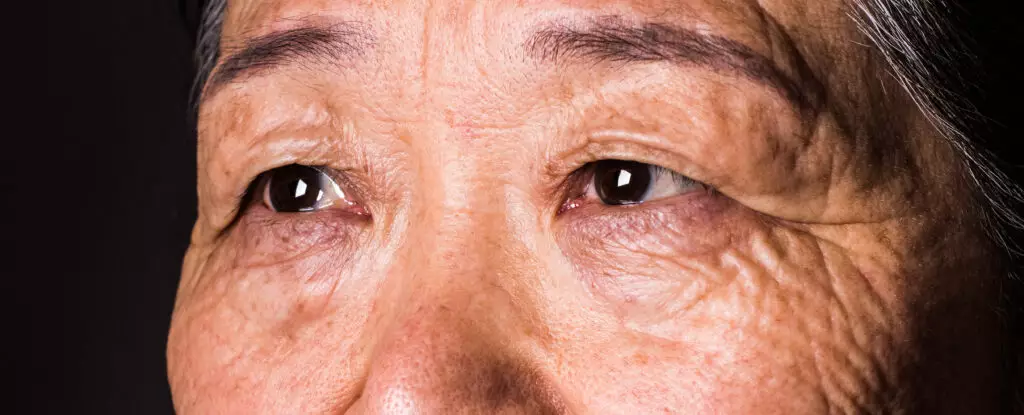The intriguing relationship between our eyesight and cognitive function is drawing increasing attention in the medical community. Recent research has illuminated a compelling narrative: deteriorating visual sensitivity may serve as one of the earliest indicators of cognitive decline, including dementia. Findings from a comprehensive study involving 8,623 healthy individuals in Norfolk, England, suggest that changes in eye functionality can forecast the onset of dementia up to 12 years in advance. This exciting revelation challenges us to reconsider the far-reaching implications of eye health, not just as a reflection of physical well-being, but as a crucial element in the intricate puzzle of brain health.
During this study, participants underwent a visual sensitivity assessment, in which they needed to react quickly upon detecting a triangle amid a shifting pattern of dots on a screen. Strikingly, those who would later receive a dementia diagnosis demonstrated a consistent lag in their responses compared to their cognitively healthy counterparts. This raises essential questions about the neurobiological mechanisms connecting vision and cognition. Could visual processing be one of the first casualties in the battle against dementia?
Neural Pathways: The Intersection of Vision and Memory
To understand why visual impairments may precede cognitive decline, one must delve into the specifics of brain deterioration associated with conditions like Alzheimer’s disease. Current hypotheses indicate that harmful amyloid plaques may first invade the areas of the brain responsible for visual processing. Only later do they encroach upon the regions tied to memory and cognitive function. Thus, visual acuity tests could provide critical insights, potentially revealing deficits long before traditional memory assessments could.
Developing a clearer perspective requires acknowledgement of the multifaceted nature of visual acuity in dementia. Sensitivity to contrast, color discrimination, and even the ability to focus on outlines can be adversely affected. For example, individuals with early-stage dementia may struggle to perceive certain colors or struggle with tracking moving objects, creating real-world implications that extend beyond the clinical environment. These deficits can permeate daily life, affecting communication, social interaction, and overall quality of life without the individual’s immediate awareness.
Eye Movements and Cognitive Control
An equally fascinating dimension of this research lies in “inhibitory control,” the brain’s ability to disregard distractions. Those with dementia exhibit noticeable struggles in this area, leading to difficulties with eye movement control. Distracting stimuli can be remarkably hard to ignore, significantly impacting tasks requiring focus, such as driving. Our research team at Loughborough University is currently investigating the ramifications of these eye movement challenges in real-life scenarios; the potential for increased accidents is a pressing concern.
Moreover, the study highlights the discrepancies in how individuals with dementia process visual information, specifically faces. Typical scanning patterns—moving gaze from the eyes to the nose and finally to the mouth—are disrupted, which could impede the ability to imprint memories of new acquaintances. This disruption isn’t simply a memory loss issue; it’s an eye movement issue directly tied to social engagement, reinforcing the idea that effective communication hinges on a healthy perceptual framework.
The Potential of Eye Movement Therapy
Intriguingly, the nexus between visual stimuli and cognitive performance raises interesting questions about the therapeutic potential of eye movements. Studies suggest that an increase in eye tracking and movement could enhance memory functions, particularly autobiographical recall. The excitement surrounding this research is palpable; the idea that deliberate eye movement might potentially serve as a non-invasive medicinal tool for cognitive enhancement invites further exploration.
Additionally, anecdotal evidence suggests that activities like reading and watching television, which naturally encourage eye movement, could correlate with lower dementia risk. This correlation, while compelling, brings attention to underlying factors such as educational background, which could act as protective variables by enhancing brain reserve capacity. Education potentially fortifies cognitive resilience, allowing individuals to better cope with inevitable neural degradation.
However, despite the promise of integrating eye movement as a diagnostic and therapeutic tool, significant barriers remain. Current eye-tracking technologies often come with prohibitive costs and require specialized training to interpret the data effectively. Until such technologies become more accessible, harnessing eye movement as an early diagnostic marker for Alzheimer’s disease remains largely confined to research labs.
The Path Forward: A Call for Innovation
As the intersection of visual and cognitive health gains prominence in both clinical and research settings, there is a pressing need for innovation. The development of affordable, user-friendly eye-tracking systems would not only facilitate early diagnosis but could revolutionize approaches to cognitive rehabilitation. By prioritizing research in this emerging field, we can bridge the gap between visual health and cognitive preservation, offering early intervention strategies that could prolong the quality of life for those at risk for dementia.
The pathway forward is laden with challenges, but it is also rich with opportunities to redefine our understanding of brain health. Embracing data-driven approaches while acknowledging the intricate relationship between vision and cognition could unlock new avenues for preventive care and enrich our lives as we age.


Leave a Reply